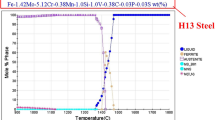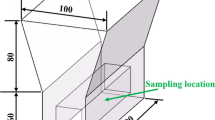Abstract
Wear is a major problem in many industrial applications, and the development of wear-resistant materials is therefore both a technical and an economic advantage. Iron-base composites bring new possibilities into the production of wear-resistant materials because of their high hardness and sufficient fracture toughness. They are suitable replacements for the conventional WC/Co cermets owing to their lower fabrication cost, better machinability, weldability, and corrosion resistance. In this study, hot-work steel/Cr3C2 composites and reference wear-resistant materials were produced by hot isostatic pressing. It was found that the matrix powder size used during processing did not affect the resultant wear properties of the composite. On the other hand, the impact toughness increased when fine matrix powders were used. The increasing reinforcement volume fraction increased significantly the hardness and wear resistance of the composite; however, the impact resistance decreased. The newly proposed hot-work steel/30 vol% Cr3C2 composite demonstrated a better combination of properties than some of the most abrasion-resistant materials available today.
Similar content being viewed by others
References
J.H. Tylczak, Abrasive Wear, Friction, Lubrication, and Technology, Vol 18, ASM Handbook, ASM International, 1992, p 184–190
P. Ettmayer and W. Lengauer, The Story of Cermets, Powder Metall. Int., Vol 21 (No. 2), 1989, p 37–38
G. Hoyle, High Speed Steels, Butterworths, 1988
K.-H. Zum Gahr and D.V. Doane, Optimizing Fracture Toughness and Abrasion Resistance in White Cast Irons, Metall. Trans. A, Vol 11,1980, p 613–620
W. Stasko, K.E. Pinnow, and W.B. Eisen, Development of Ultra-High Vanadium Wear Resistant Cold Work Tool Steels, Advances in Powder Metallurgy & Paniculate Materials, Vol 5, Part 17, Metal Powder Industries Federation, 1996, p 179–188
J.M. Panchal, T. Vela, and T. Robisch, Ferro-TiC Metal Matrix Composites for High Performance Tooling and Engineering Applications, Fabrication of Particulates Reinforced Metal Composites, J. Masounave and F.G. Hamel, Ed., ASM International, 1990, p 245–260
E. Pagounis, E. Haimi, J. Pietikäinen, M. Talvitie, S. Vahvaselkä, and V.K. Lindroos, Effect of Thermal Expansion Coefficients on the Martensitic Transformation in a Steel Matrix Composite, Scr. Mater., Vol 34, 1996, p 407–413
E. Pagounis, M. Talvitie, and V.K. Lindroos, Influence of Reinforcement Volume Fraction and Size on the Microstructure and Abrasion Wear Resistance of Hot Isostatic Pressed White Iron Matrix Composites, Metall. Mater. Trans. A, Vol 27, 1996, p 4171–4181
E. Pagounis, M. Talvitie, and V.K. Lindroos, Influence of Matrix Structure on the Abrasion Wear Resistance and Toughness of a Hot Isostatic Pressed White Iron Matrix Composite, Metall. Mater. Trans. A, Vol 27, 1996, p 4183–4191
E. Pagounis, M. Talvitie, and V.K. Lindroos, Influence of the Metal/Ceramic Interface on the Microstructure and Mechanical Properties of HIPed Iron-Based Composites, Compos. Sci. Technol., Vol 56, 1996, p 1329–1337
H. Seilstorfer, Application Fields of the HIP-Technology, Powder Metall. Int., Vol 16, 1984, p 268–271
C.M. Friend, Toughness in Metal Matrix Composites, Mater. Sci. Technol.,Vol 5, 1989, p 1–7
E. Pagounis, M. Talvitie, and V.K. Lindroos, Microstructure and Mechanical Properties of Hot Work Tool Steel Matrix Composites Produced by Hot Isostatic Pressing, Powder Metall., Vol 40, 1997,p 55–61
J.D. Bolton and M. Youseffi, Fracture Toughness of Sintered Metal Matrix Composites Based upon High Speed Steels Enriched with Hard Ceramic Carbides, Powder Metall., Vol 36, 1993, p 142–152
E. Pagounis, M. Talvitie, and V.K. Lindroos, Consolidation Behavior of a Particle Reinforced Metal Matrix Composite during HIPing, Mater. Res. Bull., Vol 31, 1996, p 1277–1285
H.M. Ledbetter and M.W. Austin, Internal Strain (Stress) in an SiC-Al Particle-Reinforced Composite: An X-Ray Diffraction Study, Mater. Sci. Eng., Vol 89, 1987, p 53–61
W.H. Hunt, Jr., T.M. Osman, and J.J. Lewandowski, Micro-and Macrostructural Factors in DRA Fracture Resistance, J. Met., Vol 45 (No. 1), 1993, p 30–35
Y. Flom and R.J. Arsenault, Effect of Particle Size on Fracture Toughness of SiC-Al Composite Material, Acta Metall., Vol 37, 1989, p 2413–2423
A. Göcke, I. Schmidt, and M. Wilhelm, Gouging and Sliding Abrasion of Austenitic Manganese Steels Reinforced by Hard Phases, Wear, Vol 119, 1987, p 313–327
M. Vardavoulias, C. Jouanny-Tresy, and M. Jeandin, Sliding-Wear Behaviour of Ceramic Particle-Reinforced High Speed Steel Obtained by Powder Metallurgy, Wear, Vol 165, 1993, p 141–149
Author information
Authors and Affiliations
Rights and permissions
About this article
Cite this article
Pagounis, E., Lindroos, V.K. Development and performance of new hard and wear-resistant engineering materials. J. of Materi Eng and Perform 6, 749–756 (1997). https://doi.org/10.1007/s11665-997-0077-1
Published:
Issue Date:
DOI: https://doi.org/10.1007/s11665-997-0077-1




